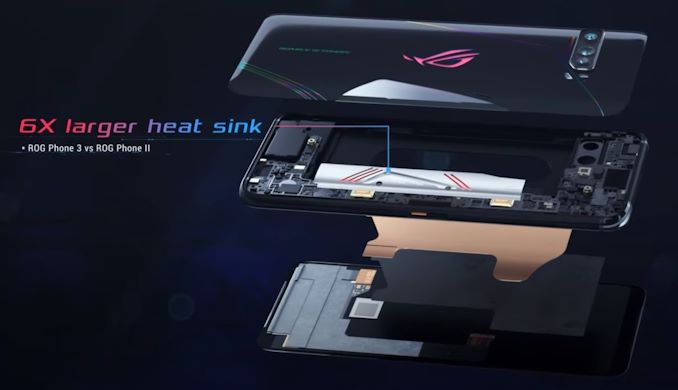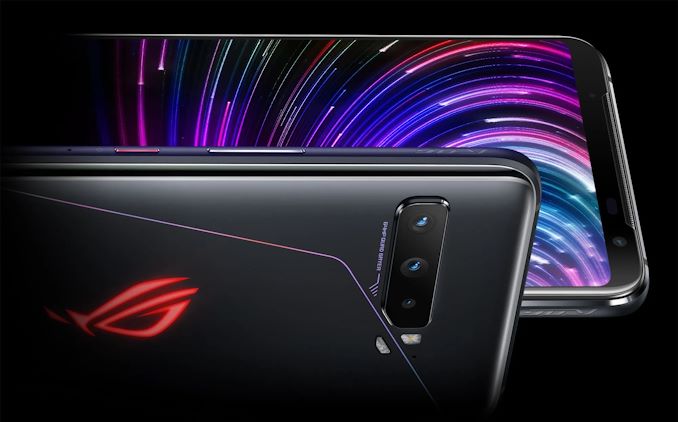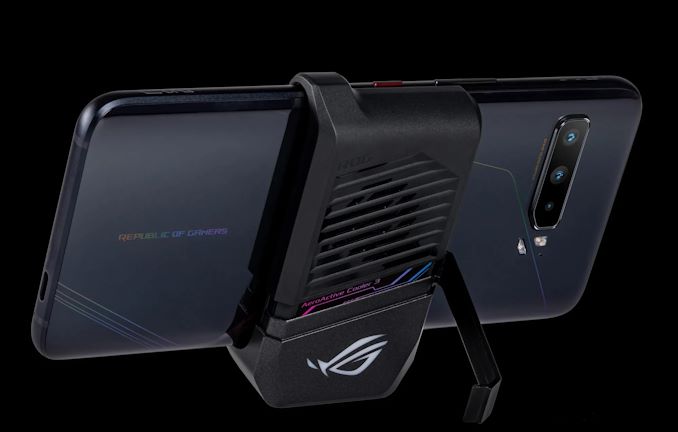ASUS Announces ROG Phone III - 144Hz S865+ Monster
by Andrei Frumusanu on July 22, 2020 1:00 PM EST- Posted in
- Smartphones
- Asus
- Mobile
- Snapdragon 865
- ROG Phone III

Today ASUS is announcing its newest flagship gaming-oriented phone, the ROG Phone III. A direct successor to the quite well received ROG Phone II from last year, the company is keeping the formula quite basic this year, keeping the general characteristics of the ROG Phone III similar to that to its predecessor whilst upgrading the core components such as the SoC, now featuring for the first time in a device the new Snapdragon 865+.
| ASUS ROG Phones | ||||||
| ROG Phone III | ROG Phone II | |||||
| SoC | Qualcomm Snapdragon 865+ 1x Cortex A77 @ 3.1GHz 3x Cortex A77 @ 2.42GHz 4x Cortex A55 @ 1.80GHz Adreno 650 @ +10% |
Qualcomm Snapdragon 855+ 1x Cortex-A76 @ 2.96GHz 3x Cortex-A76 @ 2.42GHz 4x Cortex-A55 @ 1.80GHz Adreno 640 @ 675MHz |
||||
| DRAM | 16 GB LPDDR5 | 12 GB LPDDR4X | ||||
| Storage | up to 512GB UFS 3.1 | 128 / 512GB UFS 3.0 | ||||
| Display | 6.59" AMOLED 2340 x 1080 (19.5:9) 144Hz 270Hz Touch |
6.59" AMOLED 2340 x 1080 (19.5:9) 120Hz 240Hz Touch |
||||
| Size | Height | 171.0 mm | 170.99 mm | |||
| Width | 78 mm | 77.6 mm | ||||
| Depth | 9.85 mm | 9.48 mm | ||||
| Weight | 240 grams | 240 grams | ||||
| Battery Capacity | 6000mAh 30W charging (PD) |
6000mAh |
||||
| Wireless Charging | - | |||||
| Rear Cameras | ||||||
| Main | 64MP IMX686 0.8µm pixels (1.6µm 4:1 16MP) |
48MP IMX586 0.8µm pixels (1.6µm 4:1 12MP) f/1.79 |
||||
| Telephoto | - | - | ||||
| Wide | 13MP 125° wide-angle |
13MP 125° wide-angle |
||||
| Extra | 5MP Macro | - | ||||
| Front Camera | 24MP | 24MP | ||||
| I/O | USB-C 3.1 (Side) + USB-C 2.0 (Bottom) |
USB-C 3.1 (Side) + USB-C 2.0 (Bottom) 3.5mm headphone jack |
||||
| Wireless (local) | 802.11ax WiFi-6 Bluetooth 5.1 LE + NFC |
802.11ac Wave 2 Wi-Fi Bluetooth 5.0 LE + NFC 802.11ad (Wireless display) |
||||
| Other Features | Dual Stereo Speakers Under-Display Fingerprint Sensor |
|||||
| Dual-SIM | Dual nanoSIM | |||||
| Launch Price | 8+256GB + S865 : 799€ 12+512GB + S865+: 999€ 16+512GB + S865+: 1099€ |
12+512GB: $899 / £829 / 899€ | ||||
The new SoC upgrades the CPU and GPU speeds by 10%, upping the frequencies on the Cortex-A77 cores to up to 3.1GHz for the first time ever in a smartphone. ASUS says that it’s also vastly upgraded the heat sink of the SoC inside the phone, with it now being 6x larger than that found on the ROG Phone II. Combined with a revamped vapour chamber design, the new phone is said to be virtually immune to thermal throttling and is able to keep is peak performance figures for prolonged periods even in demanding situations.
The phone also upgrades its RAM and storage options. You’re able to feature up to 16GB of LPDDR5 memory, whilst the 512GB NAND storage has been upgraded to an UFS 3.1 unit, improving transfer speeds by up to 15%.
On the display side, ASUS has kept the same screen size and resolution as on the ROG Phone II at 6.59” and 2340 x 1080, but this time around has upped the already high 120Hz refresh rate to up to 144Hz, with also an uptick in the input touch sampling rate to up to 270Hz. This being the biggest feature of the ROG Phone II, it’s arguably seen smaller upgrades this generation.
ASUS is seemingly also keeping a very similar footprint between generations as both phones still have 171 x 78mm length and widths, although the new phone is listed as being thicker at now up to 9.85mm. Weight hasn’t changed and still falls in at a hefty 240g, mostly taken up by the huge 6000mAh battery that also hasn’t seen changes this generation. Much like its predecessor, these are gigantic phones.
On the camera side of things, we’ve seen a big improvement on the main camera unit which has been switched from the previous generation IMX586 sensor to a newer IMX686. The upgrade here lies in its larger 1/1.72” sensor size, retaining 0.8µm pixels but being improved in resolution to up to 64MP with a quad-Bayer colour filter array, binning down to 16MP for regular mode shots. As of writing we don’t have information on the optics of the camera.
The ultra-wide-angle seems to have at surface remained the same at 13MP with a 125° field of view, but again we’re lacking specifics. An addition to the camera array is a 5MP macro camera which generally is more of a gimmick rather than something that augments the capture experience.
In terms of connectivity, of course the big upgrade is the move to 5G thanks to the new X55 modem. Wi-Fi 6 also the norm now and BT has been upgraded to version 5.1. We don’t see mention of ASUS’ “wireless display” functionality with 802.11ad so it might be the company has removed this feature this generation.
One other big feature that’s been removed is the 3.5mm headphone jack. Unfortunately, as in many other vendors this has gone the way of the Dodo, and is only otherwise available through ASUS’ AeroActive Cooler 3 add-on accessory which features a pass-through USB-C and 3.5mm port.
Availability in Europe later this month, the US in September
The ROG Phone III is said to first appear in Europe later this month in the form of a Strix variant with a regular Snapdragon 865 and 8+256GB of RAM for 799€, whilst the 12+512GB and 16+512GB variants will be offered later for 999€ and 1099€. In the US, the phone will only release in September with pricing there being released at a later date.
Related Reading:















64 Comments
View All Comments
ads295 - Wednesday, July 22, 2020 - link
Come on man, even on a device with no regard for size and weight, you get rid of the headphone jack? How dumbNextGen_Gamer - Wednesday, July 22, 2020 - link
Yeah, that does come across to me as well as a cheap way to push the accessory add-on in order to get the headphone jack back. Oh well. Otherwise this looks pretty solid. I hope Anandtech is able to get one in for review to put their "no throttling" feature to the test on the SD865+ silicon!imaheadcase - Wednesday, July 22, 2020 - link
Because most don't care for a headphone jack. I think i saw one person last week with one..PeachNCream - Wednesday, July 22, 2020 - link
Do you have anything beyond personal opinion and anecdotal evidence to support a claim about what the majority of people do or do not want?Notmyusualid - Saturday, July 25, 2020 - link
I use my headphone jack all the time. So, no, I won't be changing my ROG2 for ROG3.plb4333 - Wednesday, July 22, 2020 - link
ever heard of wireless?BenSkywalker - Wednesday, July 22, 2020 - link
Wireless isn't very good quality. I guess if you use Spotify and stream 320k it is probably fine, if you use even flac and more so real HD audio wireless doesn't cut it. There are those of us that spend more on our headphones then our phones.brucethemoose - Wednesday, July 22, 2020 - link
Spotify 384k (vorbis, I think?) is completely transparent on my desktop, according to a blind test I did awhile ago. If theres a difference, its pretty darn small.Anyway, you can hear definitely the transcoding on older wireless gear, but I would be very surpised if it made a difference on newer headsets. The real problem with wireless is that it adds to the cost of audio gear, which comes at the cost of quality.
marcobelli - Thursday, July 23, 2020 - link
How does audio get more ("real") HD than FLAC?Inteli - Sunday, July 26, 2020 - link
Maybe he buys into MQA, or thinks WAV is somehow higher resolution than FLAC. Either way, in a sense he's right that even modern Bluetooth audio standards like aptX HD don't have the throughput for HD audio. IIRC the highest rate those hit is around 1 Mbps, while 192/24 audio hits about 10 Mbps. On the other hand, 44.1/16 covers the entire hearing spectrum and no recording uses 16 bits of dynamic range, let alone 24, so it's probably a waste of space anyhow.I agree with the sentiment about headphone jacks. I bought my current phone almost exclusively because of the headphone jack, but with the way the wind is blowing I doubt my next phone will have one. I bought an MP3 player to handle my headphones in case the headphone jack outright vanishes, but I hope it doesn't.